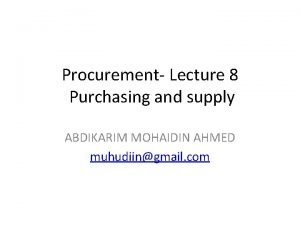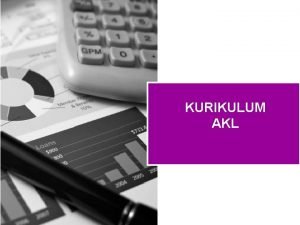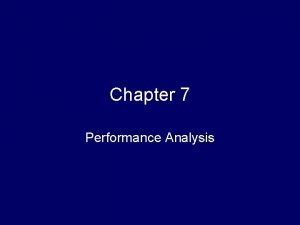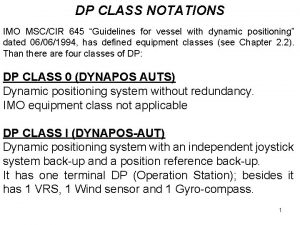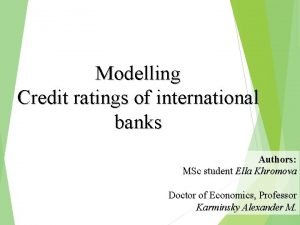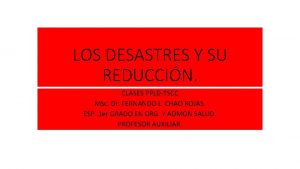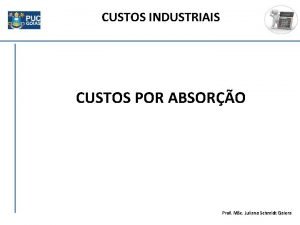Chapter 3 Dr Doaa Akl Ahmed MSc and



































- Slides: 35


Chapter 3 Dr Doaa Akl Ahmed MSc. and Ph. D. In Economics, University of Leicester, England Associate Professor of Economics, Benha University

© 2012 Pearson Addison-Wesley

What makes the prices of oil and gasoline double in just one year? Will the price of gasoline keep on rising? Are the oil companies taking advantage of people? Some prices rise, some fall, and some fluctuate. This chapter explains how markets determine prices and why prices change. © 2012 Pearson Addison-Wesley

Market and Prices • When you want to buy any good or service, you must find a place where people sell those goods or offer those services • A market is any arrangement that enables buyers and sellers to get information and do business with each other. Markets Buyers or demand side Sellers or supply side © 2012 Pearson Addison-Wesley

Market and Prices • Some markets are physical places where buyers and sellers meet. Examples of this type of market are the New York Stock Exchange and the wholesale fish, meat, and produce markets. • Some markets are groups of people spread around the world who never meet and know little about each other but are connected through the Internet or by telephone and fax. Examples are the e-commerce markets and the currency markets. © 2012 Pearson Addison-Wesley

Market and Prices Examples of markets Goods market Services markets Such as apples, phones , laptops, … etc Such as haircut, education, banking, insurance, …etc © 2012 Pearson Addison-Wesley Factors of production markets Such as teachers, equipment, … etc Inputs markets Such as memory chips and auto parts, … etc Financial markets Such as stock markets, bond markets, . . etc

Market and Prices An example: To produce a laptop: Financial market: the firm sells stocks to raise funds to invest in the production of the laptop. Factors of production market: the firm rents a factory, hire computer programmers and engineers and other related workers, buys machines to be used in the production. Inputs markets: the firm buys the different components such as processor, CPU, hard disk, sound and screen cards, CPU fan, screens, …. . Services markets: the firm gets services such operating system (windows), other software, …. Goods markets: the firm sells the laptop and consumers buy it © 2012 Pearson Addison-Wesley

Market and Prices © 2012 Pearson Addison-Wesley

Demand If you demand something, then you 1. Want it, 2. Can afford it, and 3. Have made a definite plan to buy it. Wants are the unlimited desires people have for goods and services. Demand reflects a decision about which wants to satisfy. The quantity demanded of a good or service is the amount that consumers plan to buy during a particular time period, and at a particular price. For example, suppose that you buy one cup of coffee a day. The quantity of coffee that you demand can be expressed as 1 cup per day, 7 cups per week, or 365 cups per year. © 2012 Pearson Addison-Wesley

Demand The law of demand states: Other things remaining the same, the higher the price of a good, the smaller is the quantity demanded; and, the lower the price of a good, the larger is the quantity demanded. The law of demand results from: Substitution Effect When the relative price (opportunity cost) of a good or service rises, people seek substitutes for it, so the quantity demanded of the good or service decreases. Income Effect When the price of a good or service rises relative to income, people cannot afford all the things they previously bought, so the quantity demanded of the good or service decreases. © 2012 Pearson Addison-Wesley

Demand Curve and Demand Schedule The term demand refers to the entire relationship between the price of the good and quantity demanded of the good. A demand curve shows the relationship between the quantity demanded of a good and its price when all other influences on consumers’ planned purchases remain the same. Figure 3. 1 shows a demand curve for energy bars. © 2012 Pearson Addison-Wesley

Demand A rise in the price, other things remaining the same, brings a decrease in the quantity demanded and a movement up along the demand curve. A fall in the price, other things remaining the same, brings an increase in the quantity demanded and a movement down along the demand curve. Willingness and Ability to Pay A demand curve is also a willingness-and -ability-to-pay curve. The smaller the quantity available, the higher is the price that someone is willing to pay for another unit. Willingness to pay measures marginal benefit © 2012 Pearson Addison-Wesley

Demand: A Change in Demand • When some influence on buying plans other than the price of the good changes, there is a change in demand for that good. • The quantity of the good that people plan to buy changes at each and every price, so there is a new demand curve. • When demand increases, the demand curve shifts rightward. • When demand decreases, the demand curve shifts leftward. Change in demand Prices of related goods Expected future prices © 2012 Pearson Addison-Wesley Income Expected future income population preferences

Demand: A Change in Demand Substitute Prices of related goods It is a good that can be used in place of another good It is a good that is used in Complementary combination with another good Examples of Substitute Goods Examples of Complementary goods: 1. Coca-Cola and Pepsi. 2. Car, motorbike, bike and public transport. 3. Butter and cooking oil. 4. Tea and coffee. 5. Bananas and Apples. 6. Beef and chicken 1. Cars and Petrol. 2. Shoes and Polish. 3. Computer Hardware and Computer Software. 4. Printer and Ink Cartridges. 5. Torch and Battery. 6. Pencils and Erasers. Higher price of substitute leads to higher demand on the good © 2012 Pearson Addison-Wesley Higher price of complementary leads to lower demand on the good

Demand: A Change in Demand 2 - Expected Future Prices if the expected future price of a good rises, current demand for the good increases and the demand curve shifts rightward. 3 - Income When income increases, consumers buy more of most goods and the demand curve shifts rightward. A normal good is one for which demand increases as income increases. An inferior good is a good for which demand decreases as income increases. © 2012 Pearson Addison-Wesley

Demand: A Change in Demand 4 - Expected Future Income and Credit When expected future income increases or when credit is easy to obtain, the demand might increase now. 5 - Population The larger the population, the greater is the demand for all goods. 6 - Preferences People with the same income have different demands if they have different preferences. © 2012 Pearson Addison-Wesley

Demand A Change in the Quantity Demanded Versus a Change in Demand Movement Along the Demand Curve When the price of the good changes and everything else remains the same, the quantity demanded changes and there is a movement along the demand curve. A Shift of the Demand Curve If the price remains the same but one of the other influences on buyers’ plans changes, demand changes and the demand curve shifts. © 2012 Pearson Addison-Wesley

Supply If a firm supplies a good or service, then the firm 1. Has the resources and the technology to produce it, 2. Can profit from producing it, and 3. Has made a definite plan to produce and sell it. • Resources and technology determine what it is possible to produce. Supply reflects a decision about which technologically feasible items to produce. • The quantity supplied of a good or service is the amount that producers plan to sell during a given time period at a particular price. © 2012 Pearson Addison-Wesley

Supply The Law of Supply states that Other things remaining the same, the higher the price of a good, the greater is the quantity supplied; and the lower the price of a good, the smaller is the quantity supplied. The law of supply results from the general tendency for the marginal cost of producing a good or service to increase as the quantity produced increases. Producers are willing to supply a good only if they can at least cover their marginal cost of production. © 2012 Pearson Addison-Wesley

Supply Curve and Supply Schedule The term supply refers to the entire relationship between the quantity supplied and the price of a good. The supply curve shows the relationship between the quantity supplied of a good and its price when all other influences on producers’ planned sales remain the same. © 2012 Pearson Addison-Wesley

Supply: A Change in Supply When some influence on selling plans other than the price of the good change there is a change in supply of that good. The quantity of the good that producers plan to sell changes at each and every price, so there is a new supply curve. When supply increases, the supply curve shifts rightward. When supply decreases, the supply curve shifts leftward. Change in supply Prices of factors of production Prices of related goods © 2012 Pearson Addison-Wesley Number Expected future of prices suppliers Technology State of nature

Supply: A Change in Supply Prices of related goods produced substitute in production complements in production It is another good that can be produced using the sane resources Goods are complement in production if they must be produced together Examples of Substitute in production Examples of Complementary in production 1. substitute crops, such as corn or wheat 2. multi-family apartment buildings or single-family houses 3. four-door sedans or pickup trucks 1. wheat and hay. 2. beef and cowhide (leather from the same cattle resource). 3. Processor and a laptop The supply of a good increases if the price of a substitute in production falls © 2012 Pearson Addison-Wesley The supply of a good increases if the price of a complement in production rises.

Supply: A Change in Supply 2 - Prices of Factors of Production • If the price of a factor of production used to produce a good rises, the cost of productions increases and suppliers is willing to accept higher prices for producing each quantity of that good rises. • So a rise in the price of a factor of production decreases supply and shifts the supply curve leftward. 3 - Expected Future Prices • If the expected future price of a good rises, the supply of the good today decreases and the supply curve shifts leftward. © 2012 Pearson Addison-Wesley

Supply: A Change in Supply 4 - The Number of Suppliers • The larger the number of suppliers of a good, the greater is the supply of the good. An increase in the number of suppliers shifts the supply curve rightward. 5 - Technology • Advances in technology create new products and lower the cost of producing existing products leading to increase supply and shift the supply curve rightward. 6 - The State of Nature • The state of nature includes all the natural forces that influence production—for example, the weather. • A natural disaster decreases supply and shifts the supply curve leftward. © 2012 Pearson Addison-Wesley

Supply: A Change in the Quantity Supplied Versus a Change in Supply Movement Along the Supply Curve When the price of the good changes and other influences on sellers’ plans remain the same, the quantity supplied changes and there is a movement along the supply curve. A Shift of the Supply Curve If the price remains the same but some other influence on sellers’ plans changes, supply changes and the supply curve shifts. © 2012 Pearson Addison-Wesley

Market Equilibrium is a situation in which opposing forces balance each other. Equilibrium in a market occurs when the price balances the plans of buyers and sellers. The equilibrium price is the price at which the quantity demanded equals the quantity supplied. The equilibrium quantity is the quantity bought and sold at the equilibrium price. § Price regulates buying and selling plans. § Price adjusts when plans don’t match. © 2012 Pearson Addison-Wesley

Market Equilibrium Price as a Regulator Figure 3. 7 illustrates the equilibrium price and equilibrium quantity. If the price is $2. 00 a bar, the quantity supplied exceeds the quantity demanded. There is a surplus of 6 million energy bars If the price is $1. 00 a bar, the quantity demanded exceeds the quantity supplied. There is a shortage of 9 million energy bars. If the price is $1. 50 a bar, the quantity demanded equals the quantity supplied. There is neither a shortage nor a surplus of energy bars. © 2012 Pearson Addison-Wesley

Market Equilibrium Price Adjustments • At any price above the equilibrium price, a surplus forces the price down. • At any price below the equilibrium price, a shortage forces the price up. • At the equilibrium price, buyers’ plans and sellers’ plans agree and the price doesn’t change until some event changes either demand or supply. © 2012 Pearson Addison-Wesley

Predicting Changes in Price and Quantity An Increase in Demand Figure 3. 8 shows that when demand increases the demand curve shifts rightward. At the original price, there is now a shortage. The price rises, and the quantity supplied increases along the supply curve. © 2012 Pearson Addison-Wesley

Predicting Changes in Price and Quantity An Increase in Supply Figure 3. 9 shows that when supply increases the supply curve shifts rightward. At the original price, there is now a surplus. The price falls, and the quantity demanded increases along the demand curve. © 2012 Pearson Addison-Wesley

Predicting Changes in Price and Quantity All Possible Changes in Demand Supply A change demand or supply or both demand supply changes the equilibrium price and the equilibrium quantity. © 2012 Pearson Addison-Wesley

Predicting Changes in Price and Quantity Change in Demand with No Change in Supply When demand increases, there is a movement up along the supply curve. The equilibrium price rises and the equilibrium quantity increases. © 2012 Pearson Addison-Wesley

Predicting Changes in Price and Quantity When demand decreases, the equilibrium price falls and the equilibrium quantity decreases. © 2012 Pearson Addison-Wesley

Predicting Changes in Price and Quantity Change in Supply with No Change in Demand When supply increases, there is a movement down along the demand curve. The equilibrium price falls and the equilibrium quantity increases. © 2012 Pearson Addison-Wesley
 Dr. ahmed akl
Dr. ahmed akl Ahmed muhudiin ahmed
Ahmed muhudiin ahmed Struktur kurikulum akl
Struktur kurikulum akl Selim akl
Selim akl Akl flow designer download
Akl flow designer download Msc in construction law
Msc in construction law Bsc and msc in telecom
Bsc and msc in telecom Msc finance and banking tor vergata
Msc finance and banking tor vergata Ideology of sir syed ahmed khan
Ideology of sir syed ahmed khan The hajji short story
The hajji short story Front office operations and management ahmed ismail
Front office operations and management ahmed ismail Msc trakcing
Msc trakcing Nsozvn
Nsozvn Hapag qq
Hapag qq Cpit courses
Cpit courses Almacenes msc
Almacenes msc Grenoble ecole de management msc finance
Grenoble ecole de management msc finance Prof msc
Prof msc Msc international business birmingham
Msc international business birmingham Jma msc
Jma msc 7 aplikasi perdana msc
7 aplikasi perdana msc Msc sirkka
Msc sirkka Dp class
Dp class Network msc
Network msc Msc eir
Msc eir Msc sandra
Msc sandra Milan miljevic
Milan miljevic 2vision msc
2vision msc Ship construction file
Ship construction file Cass msc actuarial management
Cass msc actuarial management Msc bis
Msc bis Msc credit rating
Msc credit rating Meteorological satellite center of jma
Meteorological satellite center of jma Tscc.msc
Tscc.msc Diverkasi
Diverkasi Msc
Msc

